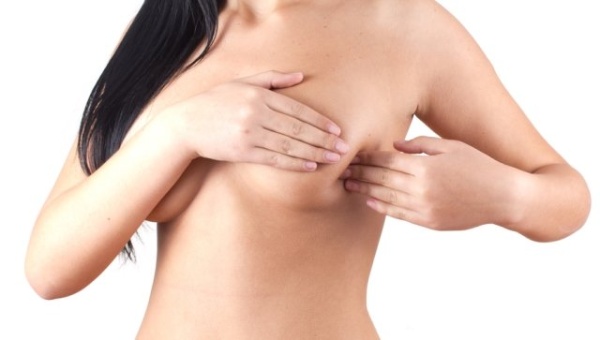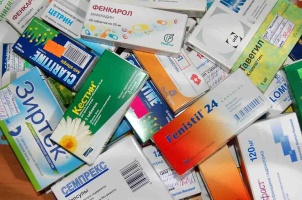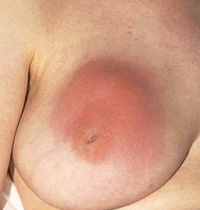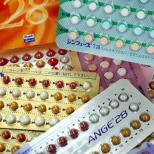Pain in the mammary gland - causes and treatment
The mammary glands have a rather fragile hormonal balance, which is better to initially maintain at the proper level.
If preventive care is not taken, a symptom known as breast pain may occur. Pain of varying degrees of intensity often worries women - there are reasons for this.
Often the pain is accompanied by a feeling of fullness, heaviness, increased sensitivity of the nipples and their swelling. Pain in the mammary gland can also occur before menstruation.
Not always the cause of pain is an oncological or mammological disease. But you still need to go to the doctor.

Depending on the periods of occurrence of pain in the mammary gland, there are:
- cyclical pain (occurs before hormonal transformations and before menstruation);
- non-cyclic pain (it is usually associated with bruises, injuries and intercostal neuralgia).
By its nature, the pain of the mammary glands is divided into the following groups:
- shooting;
- dull;
- acute;
- stabbing;
- cutting;
- pulsating;
- aching (or aching-pulling);
- burning.
Symptoms
Symptoms inherent in the cyclic pain syndrome of the glands:
- connection with menstruation;
- aching and dull character;
- inflammatory process;
- the appearance of nodules in the chest;
- return to the armpits;
- symmetry (pain is felt in both breasts);
- age factor (patients 20-40 years old suffer from a symptom more often).

Symptoms of non-cyclic soreness:
- lack of connection with menstruation;
- squeezing and burning in the chest;
- localization in one area of \u200b\u200bthe chest (left or right);
frequency of lesions in women in the menopausal stage.
Dangerous symptoms:
- daily pain lasting more than 2 weeks;
- increased pain over time
- localization in a strictly defined area of \u200b\u200bthe chest;
- breast pain causes difficulty in daily activities.
Causes
Factors contributing to the occurrence of discomfort (that is, their causes) are different:

Probable diseases
The symptom can be caused by various injuries and bruises of the mammary glands, as well as changes in the body in the early stages of pregnancy. Before proceeding with treatment, you need to realize the cause of the ailment, because more serious pathologies are not excluded.
Intercostal neuralgia
It develops as a result of a violation of the sensitivity of individual nerve fibers. Painful sensations “spread throughout the entire nerve (trunk and branches), so not only the mammary glands, but also the back and lower back can hurt.
Neuralgia in the region of the glands is characterized by intensity, paroxysmal and increased when walking. Pain also occurs when pressing on the chest, exhaling and inhaling.
Mastopathy
Refers to benign diseases of the mammary glands. At the same time, the tissues of the glands grow, and fluid begins to stand out from the nipple. Mastopathy affects two breasts at once.
The pain becomes aching and dull. An interesting fact is that 15% of women suffering from mastopathy do not experience pain at all. In some cases, mastopathy is transformed into a cancerous tumor.
Fibroadenoma of the breast
The treatment of this tumor-like formation is extremely problematic. The encapsulated tumor at the same time has rather accurate contours.
The chest thickens, the nipples secrete a strange substance. If a woman is faced with an ailment in adulthood, doctors recommend surgery. Fibroadenoma is a benign tumor, so it does not violate the very structure of the breast. Transformation to sarcoma is extremely rare.

We are talking about inflammation of the mammary glands. The disease can develop if hygiene standards are not observed or during the lactation period. The infection enters the body through microcracks in the nipples.
The pain syndrome intensifies in the process of feeding. A typical mistake is the identification of mastitis and mastopathy. These are different pathologies, and the second is more dangerous.
Diagnostics
Before embarking on treatment, it is important to conduct a competent diagnosis of the disease. The following methods are used for this:
- ultrasound. The most popular method, we will not dwell on it.
- Palpation. The patient undresses to the waist and allows the doctor to feel the affected area - with her hands raised behind her head and lowered. At this stage, the asymmetry of the mammary glands is revealed. Such an examination allows you to visually determine swelling, redness, the condition of the subcutaneous vessels. Pain in the mammary gland is also diagnosed at this stage, the exact localization of the problem is detected. Lymph nodes (supraclavicular, subclavian, axillary, cervical) are also examined.
- Biopsy. There are three types: excisional (excision of the seal along with adjacent tissues), puncture (introduction of a needle or syringe into the seal), trephine biopsy (with the help of needles, a tissue column is isolated for subsequent research). Before menstruation or after them there is an examination - it does not matter. The main thing is to determine the nature of the tumor (benign, malignant).
- Mammography. This is the process of X-ray diagnostics of processes occurring in the mammary gland. For this procedure, a special X-ray machine is used - a mammograph.
- Ductography. Diagnosis using a radiopaque preparation, which helps to identify a tumor in the mammary gland, if this formation is located in the ducts.
- Thermography. The research mechanism is a thermal imager. This device is sensitive to infrared rays emitted by our body. A hot spot will be marked above the affected area.
- Ultrasound diagnostics. The second name of the method is echography. Thanks to ultrasound, the data obtained by X-rays are significantly supplemented.
- Pneumocystography. It implies a puncture of the cyst cavity.
At-risk groups
Problems with pain in the mammary gland can occur not only before menstruation. The risk group includes:

Treatment
Properly carried out before treatment, the diagnosis can show the absence of a connection with functional disorders of the mammary gland.
In this case, the doctor prescribes symptomatic treatment. For example, anti-prolactin drugs fight elevated prolactin levels. They can also suppress the secretion of this hormone by the pituitary gland.
Hormone therapy has a significant drawback - it knocks down the menstrual cycle. Therefore, it is used extremely rarely. More common in medical practice are:
- phytotherapy;
- nutritional supplements;
- vitamin therapy.
A popular diet is aimed at eliminating coca-cola, chocolates, alcohol and coffee from the diet. In some cases, pyridoxine is used. The price of this drug ranges from 30 rubles.
Conservative treatment
Your doctor may prescribe the following medications:
- vitamins (E, A, C, B);
- sedatives and anti-stress agents;
- drugs to normalize the synthesis of sex hormones;
- enzymes (regulate metabolism).
Surgical intervention
If none of the above treatments work, the patient may be sent for surgery. This means the removal of areas affected by tumor-like formations. After the operation, the patient is prescribed immunomodulating, analgesic and antitumor drugs.
Prevention
The best prevention is a systematic strengthening of immunity. It is also necessary to avoid stress, anxiety and nervous tension, have regular sex with the same partner, avoid abortions and breastfeed the baby. It is worth abandoning a tight bra and devoting time to a manual examination annually.





